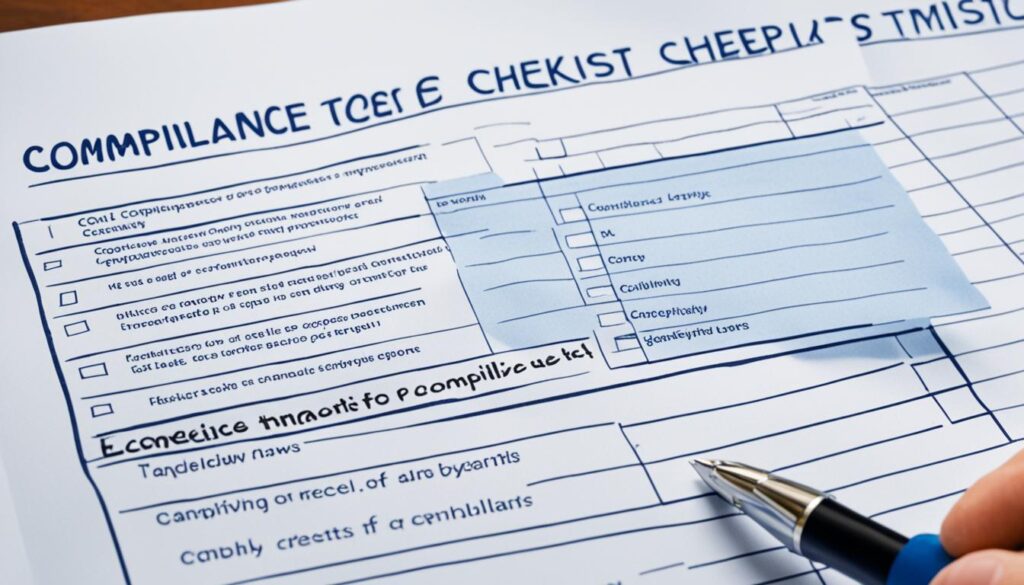Did you know that, as an employer, you are responsible for withholding a portion of each employee’s income, ensuring that Social Security and Medicare contributions are made, not to mention navigating through a jungle of compliance forms like the IRS Form W-2? Starting out as a sole proprietor, this can sound daunting, especially when considering the complexities of hiring your first employee. Yet, with the essential steps outlined in this sole proprietor hiring guide, you’ll discover how to hire employees as a sole proprietor, evolving from a one-person operation into a thriving business with a capable team.
Key Takeaways
- Understand the necessity of an Employer Identification Number (EIN) when starting the hiring process for sole proprietors.
- Learn how to manage employment records, like Form I-9, and maintain compliance with IRS and ICE regulations.
- Recognize the value of establishing solid hiring frameworks, including personnel files and a comprehensive employee handbook.
- Comprehend the importance of implementing a strategic recruitment approach, tailored to your needs, utilizing job boards and candidate networks.
- Realize the imperative of including attractive employee benefits packages to become competitive in today’s job market.
Understanding Sole Proprietorship and Employee Recruitment
Embarking on a journey as a sole proprietor offers unmatched autonomy and ease of management, characteristics that make a sole proprietorship especially attractive for many aspiring entrepreneurs. As the sole decision-maker, it’s important to understand that starting such an endeavor involves minimal formal steps and unlike corporations, there’s no need to register the business with the state. This streamlined setup allows for a shorter path from concept to operation, fueling your entrepreneurial spirit with quick and direct action.
Defining Sole Proprietorship
A sole proprietorship is perhaps the simplest form of business, where one individual is affirmatively the business itself. This means that the proprietor shoulders direct accountability for the business’s debts and assets. Consequently, there’s no legal distinction between personal and business assets, which can expose you to greater risk. Nevertheless, the ease of sole proprietor recruitment without the need to file regular state renewals or reports marks a high point for individuals valuing an uncomplicated business structure. Uniquely, sole proprietors absorb business income as personal income, simplifying tax affairs considerable.
The Legality of Hiring as a Sole Proprietor
When deliberating on hiring as a sole proprietor, understand that while you maintain full control, some legalities still bind you. An Employer Identification Number (EIN) stands as a fundamental requirement, not only for tax purposes but also as a precondition by some banks for opening business accounts. In addition, different industries may necessitate various licenses or zoning clearances for lawful operations. Compliance, hence, becomes a critical part of expanding your team.
Risks and Responsibilities When Expanding Your Team
- While the thought of expansion can be exciting, remember the risks of hiring employees as a sole proprietor. Any employees hired fall under your direct provinciality which includes ensuring proper insurance coverage like workers’ compensation and liability insurance.
- Adopting technologies such as Applicant Tracking Systems like BambooHR, Pinpoint ATS, and ClearCompany can enhance recruitment processes while ensuring compliance with Equal Employment Opportunity laws and fostering diversity in your recruitment approaches.
- As an employer, you also shoulder the responsibility for both employer and employee portions of Social Security and Medicare taxes, a distinction not found in entity structures that offer more personal asset protection.
In conclusion, while the journey of hiring as a sole proprietor may seem daunting, grasp the plethora of resources and smart technologies at your disposal to safeguard your business while fostering a strong team that aligns with your mission and values.
Preparing to Hire: Compliance and Documentation Essentials

As you embark on the journey of expanding your sole proprietorship by hiring your first employee, it’s essential to understand the compliance and documentation required for a smooth transition. Preparing to hire involves not just finding the right person for the job but also ensuring that your legal and regulatory responsibilities as an employer are fully addressed. With thorough preparation, sole proprietors like you can navigate the hiring process with confidence, adhering to vital requirements and setting the stage for robust business growth.
To help you in this process, let’s first discuss the need for securing an Employer Identification Number (EIN). This number acts as a Social Security number for your business and is crucial for reporting taxes and other documents to the IRS. If you haven’t already applied for an EIN, it’s a straightforward first step in your documentation for sole proprietor hiring journey. The application can be completed online on the IRS website and is usually processed immediately.
Next, you’ll need to gather necessary employee documentation. Initially, ensure the proper completion of Form I-9 for employment eligibility verification and Form W-4 for tax withholding purposes. Along with these standard forms, maintaining detailed records including personal information, employment terms, emergency contacts, and signed agreements or contracts is critical. Accurate and thorough documentation supports compliance for sole proprietors and aids in protecting both you and your employees.
Lastly, establish clear employee policies and procedures to limit liability and create a transparent work environment. This includes:
- Building a robust employee handbook detailing job responsibilities, workplace policies, and behavior expectations.
- Ensuring compliance with various employee rights and labor laws, which can include minimum wage requirements (like the $7.25 federal baseline or Oregon’s $13.50 state minimum wage), workplace safety standards by OSHA, and non-discrimination policies.
- Staying abreast of industry-specific regulations, such as the California Consumer Privacy Act (CCPA) for businesses meeting certain criteria, and immigration laws overseen by the Department of Homeland Security (DHS), ensuring fair and legal hiring practices.
Incorporating best practices in cybersecurity by training employees on security principles is another layer of preparedness that can’t be overlooked. Following recommendations from the updated FCC Cybersecurity Tip Sheet, such as requiring password protection for devices and establishing firewall security, not only protects your data but also reinforces the integrity of your sole proprietorship in the digital landscape.
With the right compliance software, like Donesafe and Libryo, you can streamline the management of these various requirements and ensure that you remain aligned with ever-evolving regulations. Remember, regular HR audits are recommended to assess and maintain compliance in all areas of your business operations.
Preparing to hire as a sole proprietor also involves understanding the oversight provided by multiple regulatory bodies and leveraging resources such as the Global Cyber Alliance’s cybersecurity toolkit or Microsoft’s cybersecurity tips for small businesses. These resources can provide invaluable guidance as you work to secure your business and ensure a safe, compliant hiring process.
By embracing these documentation and compliance measures, you are laying the groundwork for a strong, sustainable expansion of your business. Start this exciting new chapter equipped with the knowledge and tools to succeed.
How to Hire Employees as a Sole Proprietor
Hiring employees as a sole proprietor can be a significant step forward in your business journey. Not only does it mean that your business is growing, but it also introduces a new realm of tax and legal responsibilities. To guide you through the sole proprietor hiring process, here’s a walkthrough of the steps to hire employees as a sole proprietor, starting with obtaining an Employer Identification Number (EIN).
Securing an Employer Identification Number (EIN)
Before you start the search for your next team member, the first order of business is securing an EIN from the IRS. This number is crucial for reporting taxes and other important documents to the government. To initiate the hiring employees as a sole proprietor process, you’ll need to apply for an EIN through the IRS website or by mailing in the appropriate form. Remember, an EIN is a necessity for all employers, not an option.
Gathering Necessary Employee Documentation
When you’ve identified a potential hire, it’s essential to gather the necessary documentation. Every U.S. employer must complete a Form I-9 for every individual they hire. Make sure your new employee provides a Social Security Number (SSN), as an Individual Taxpayer Identification Number (ITIN) isn’t sufficient for employment purposes. Additionally, keep a Form W-4 on file for each employee to properly withhold income tax.
Here are some important facts:
- An ITIN is recognizable as it starts with a “9” and is formatted like an SSN but cannot be used in place of one for employment.
- For employees claiming exemption from income tax withholding, they must inform you via their Form W-4.
- Tax withholding based on a new Form W-4 must start no later than the beginning of the first payroll period ending 30 days after the form was received.
Consider using the IRS’s tax withholding estimator to confirm the adequacy of an employee’s tax withholding. This tool is especially useful in ensuring that the steps to hire employees as a sole proprietor include accurate tax practices.
Establishing Employee Policies and Procedures
Even as a sole proprietor, it’s important to establish clear policies and procedures for your employees. Creating an employee handbook that outlines at-will employment, pay schedules, benefits, and equal employment opportunities is a best practice. Remember, these parameters not only keep you compliant but also set clear expectations for your team and help protect your business from potential legal issues.
Agricultural employers should take note that specific rules for tax withholding may apply to them, as detailed in Publication 51, (Circular A), Agricultural Employer’s Tax Guide. Therefore, always make sure to consult such guides pertinent to your industry.
Sole Proprietor Hiring Guide: Payroll and Compensation
As you embark on the journey of expanding your sole proprietorship by hiring employees, understanding the payroll process for sole proprietors is vital for legal compliance and the smooth operation of your business. The key elements involve calculating gross pay, adhering to tax withholding obligations, and choosing a suitable payroll system to pay employees as a sole proprietor.

Every employer in the United States, including you as a sole proprietor, must properly complete an Form I-9 for each individual they hire. This form is critical for verifying employment eligibility. Additionally, new employees are required to provide a signed Form W-4 before their start date, which must be in effect with their first wage payment. It’s important to note that necessarily, a Form W-4 will remain in place until an update is provided by the employee. However, if an employee wishes to claim exemption from income tax withholding, they must renew their Form W-4 annually.
When setting up sole proprietor payroll, consider using an Individual Taxpayer Identification Number (ITIN) for employees who do not have a Social Security Number (SSN). An ITIN is a 9-digit number used for tax purposes, and it’s essential for proper tax reporting.
- Withholding accuracy is also a cornerstone of sole proprietor compensation. You can guide your employees towards using the IRS tax withholding estimator to ensure the correct amount of tax is withheld from their paychecks.
- Choosing a payroll service or software can simplify the payroll process, as it can automate payments and tax calculations, saving you time and reducing the potential for errors.
By staying informed on these payroll requirements and implementing efficient systems, you can streamline paying employees as a sole proprietor and maintain your focus on growing your business.
Sole Proprietor Recruitment Strategies: Attracting the Right Talent
As you navigate the intricacies of being a sole proprietor, understanding recruitment strategies is key to your business growth. One of the biggest shifts in the hiring landscape is the rise in remote work environments and the demand for flexible schedules, which are massive incentives for the modern workforce. A sole proprietor needs to acknowledge this trend by offering competitive benefits, including the flexibility of work arrangements post-pandemic, which has become an expectation rather than a perk.
Crafting effective job descriptions for sole proprietors is not just about listing responsibilities; it’s about showcasing the uniqueness of your business and how it aligns with current innovations and trends. Candidates are looking for roles that respect their need for work-life balance while offering opportunities to contribute to meaningful projects. Highlighting these aspects can set you apart and help attract talent that matches your business ethos.
Crafting Effective Job Descriptions
- Identify the core responsibilities and qualifications with clarity and precision.
- Emphasize the unique aspects of working with your company, such as autonomy and direct impact.
- Incorporate language that reflects the culture and values of your business.
Conducting Interviews and Assessing Candidates
Conducting interviews as a sole proprietor allows you to directly assess if candidates are a cultural and professional fit. It’s important to develop a structured interview process that evaluates not just skills and experience but also adaptability and alignment with your business’s core values.
- Create a consistent set of interview questions that evaluate both technical competencies and soft skills.
- Use behavioral interview techniques to understand how candidates would react in real-world scenarios relevant to your business.
- Ensure the interview process is free from bias and adheres to equal opportunity principles.
Best Practices for Onboarding New Hires
Once the interviews conclude, and you’ve selected the right candidate, a solid onboarding process is critical to ensure they are set up for success. This involves more than just a welcome email; it entails training, establishing clear expectations, and integrating them into your business culture. Networking with professionals in your field and tapping into industry trends can provide you with insights into creating an effective onboarding experience. Recognition and respect towards your new employees will not only motivate them but also foster loyalty and high retention rates, a crucial component for any growing business.
Incorporating modern tools like marketing automation can significantly enhance your ability to reach and engage potential hires. Studies have shown that utilizing automation can boost lead generation by over 450%, a statistic that illustrates the power of technology in amplifying your recruitment efforts. Incorporate employer branding that connects with real-world issues to motivate potential hires to join your cause. Additionally, connecting with local higher education institutions can assist in building a pipeline of enthusiastic students keen on gaining work experience, injecting fresh talent and perspectives into your business.
Attracting talent as a sole proprietor involves understanding that your role is multifaceted – you are the heart of your company and the face of its future. By embracing these tailored strategies and tapping into the social media landscape, you can build affinity and trust with potential employees, allowing you to grow your team with the right people who are committed to your vision.
Transitioning from Sole Proprietorship: When to Upgrade
As your business evolves, you may find that transitioning from sole proprietorship to a more structured entity could be in your best interests. The shift could afford you better liability protection and offer potential tax advantages. But when exactly should you consider upgrading your business structure? You might start by looking at the administrative side of things. If, for instance, your annual liability for employment taxes falls under $1,000, you may be currently eligible to file Form 944 annually. However, as you scale up and this liability exceeds the threshold, the need to transition becomes more apparent, steering you towards more frequent filings like Form 941 each quarter.
Moreover, with growth often comes the need to streamline processes, as employing a staff significantly changes how taxes are managed. Efficiently handling electronic payments through electronic funds transfer (EFT) will be critical since the IRS mandates that employers deposit all employment taxes electronically. Simultaneously, you need to provide recipients with Forms 1099-MISC and 1099-NEC, accurately reflecting their earnings and facilitating their own tax responsibilities. In this landscape, reevaluating your business form can often simplify these processes.
Lastly, as a sole proprietor, self-employment tax comes into play if your net earnings reach or exceed $400. The switch to a more sophisticated entity could alter tax obligations significantly. Employers, including yourself, will have to contend with the nuances of not withholding taxes on income should you provide a TIN. And while some aspects of transitioning may seem minute, like the ability to deduct business gifts up to a specific value, they highlight the intricate financial considerations of choosing an optimal structure. Pondering when to restructure a sole proprietorship? It’s not just about size or revenue—it’s about preparing for the future complexity and potential of your growing business. Seeking professional advice is highly recommended to navigate this transformative phase gracefully.
FAQ
What is a sole proprietorship?
What are the legal requirements for hiring employees as a sole proprietor?
What are the risks and responsibilities when expanding my team as a sole proprietor?
How do I secure an Employer Identification Number (EIN) for my sole proprietorship?
What employee documentation do I need to gather when hiring as a sole proprietor?
How do I establish employee policies and procedures as a sole proprietor?
What should I consider when calculating payroll and compensation as a sole proprietor?
How can I attract the right talent as a sole proprietor?
What are the best practices for onboarding new hires in a sole proprietorship?
When should I consider transitioning from a sole proprietorship to another business structure?
Author
-

Sophia Alvarez brings extensive knowledge in employee management and strategic hiring practices. With over 15 years in HR, she has pioneered innovative approaches to talent acquisition and workforce planning.
View all posts



